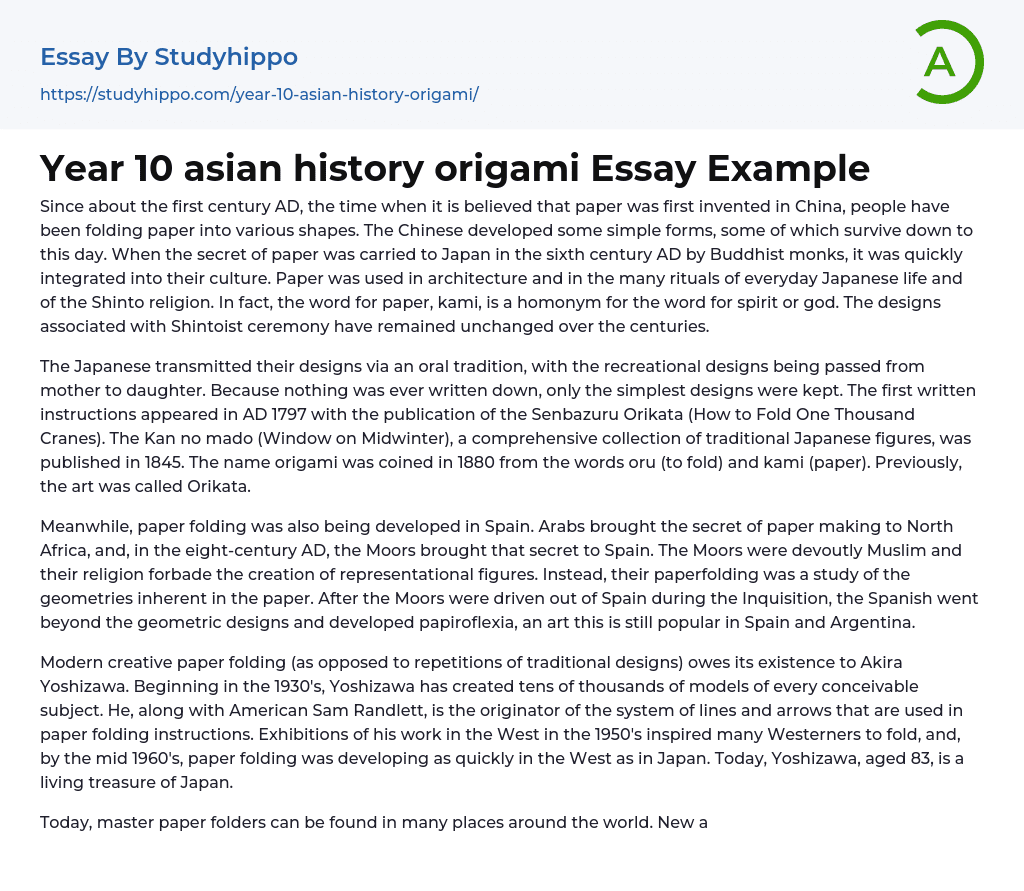Paper folding, believed to have been invented in China during the first century AD, has a long history that spans across different cultures. The Chinese initially created simple forms which still exist today. In the sixth century AD, Buddhist monks brought the knowledge of paper to Japan where it quickly became an integral part of Japanese culture. Paper was utilized in various aspects such as architecture, daily rituals, and within the Shinto religion. Interestingly, "kami," the Japanese word for paper, is also a homonym for spirit or god.
The designs associated with Shintoist ceremonies have remained unchanged over time and were traditionally passed down orally from mothers to daughters. However, only the simplest designs were preserved since there was no written documentation until 1797 when Senbazuru Orikata (How to Fold One Thousand Cranes) was published. In 1845, a comprehensive collection
...of traditional Japanese figures known as Kan no mado (Window on Midwinter) was released.
Origami is the term coined in 1880 for this art form; it derives from combining "oru" (to fold) and "kami" (paper). Furthermore, paper folding techniques developed in Spain influenced by Arabs who introduced paper making secrets to North Africa and later Spain during the eighth century AD. The Moors adhered to their religious beliefs that prohibited them from creating representational figures but focused on studying geometries inherent in paper folding instead. After being expelled from Spain during the Inquisition period, Spanish artists took their paper folding skills further and developed papiroflexia as a distinct art form.
This art form remains popular in Spain and Argentina. Akira Yoshizawa is credited with modern creative paper folding, as opposed to traditional designs. Starting in the 1930s, Yoshizaw
produced thousands of models covering various subjects. Alongside American Sam Randlett, he developed the system of lines and arrows used in paper folding instructions. His exhibitions in the West during the 1950s inspired many Westerners to take up folding. By the mid-1960s, paper folding was advancing rapidly both in Japan and the West. At 83 years old, Yoshizawa is considered a living treasure of Japan.
Thanks to new techniques that have produced astonishing models, skilled paper folders can now be found worldwide. What was once impressive - representing insects with segmented bodies and multiple legs - is now ordinary. The new achievement is creating anatomically correct insects that resemble specific species and continue to amaze people.
Fortunately, not all paper folders have solely focused on technical skill; the artistry of paper folding continues to thrive. The choice of composition and paper has played a crucial role in this artistic renaissance. Yoshizawa has been at the forefront of this movement, using dioramas, mobiles, and shadow boxes to effectively capture the essence of his subjects through incredible displays.He has revolutionized the field with his innovative technique called backcoating, which involves laminating two layers of handmade mulberry paper (such as unryu or chiri) to achieve an unrivaled folding experience. Another technique known as wet folding allows for sculpting models into soft curves and three-dimensional forms by folding heavily sized paper while it is still damp. Origami has gained immense popularity not only in Japan, where dedicated shows instruct enthusiasts on creating specific models but also in the Western world. It has proven to be an effective form of therapy and relaxation for individuals experiencing stress, as well as mental health
patients.
- Russian Empire essays
- Ancient Greece essays
- British Empire essays
- Historical Figures essays
- Nazi Germany essays
- Roman Empire essays
- War essays
- Revolution essays
- 19Th Century essays
- Historiography essays
- History of the United States essays
- 20Th Century essays
- World History essays
- Vikings essays
- Declaration of Independence essays
- Civilization essays
- Evidence essays
- Genocide essays
- Colonialism essays
- Rebellion essays
- 1960S essays
- 1920S essays
- 1950S essays
- Letter from Birmingham Jail essays
- Louisiana Purchase essays
- The Columbian Exchange essays
- World Hunger essays
- What is History essays
- Bravery essays
- Gilded Age essays
- Vladimir Lenin essays
- Alexander The Great essays
- Sparta essays
- Victorian Era essays
- Henry v essays
- Stonehenge essays
- Frederick Douglass essays
- Mahatma Gandhi essays
- Joseph Stalin essays
- Geert Hofstede essays
- George Eliot essays
- Ginevra King essays
- John Keats essays
- Siegfried Sassoon essays
- Ben jonson essays
- Billy elliot essays
- Wilkie collins essays
- John Proctor essays
- Harriet Tubman essays
- Napoleon essays




